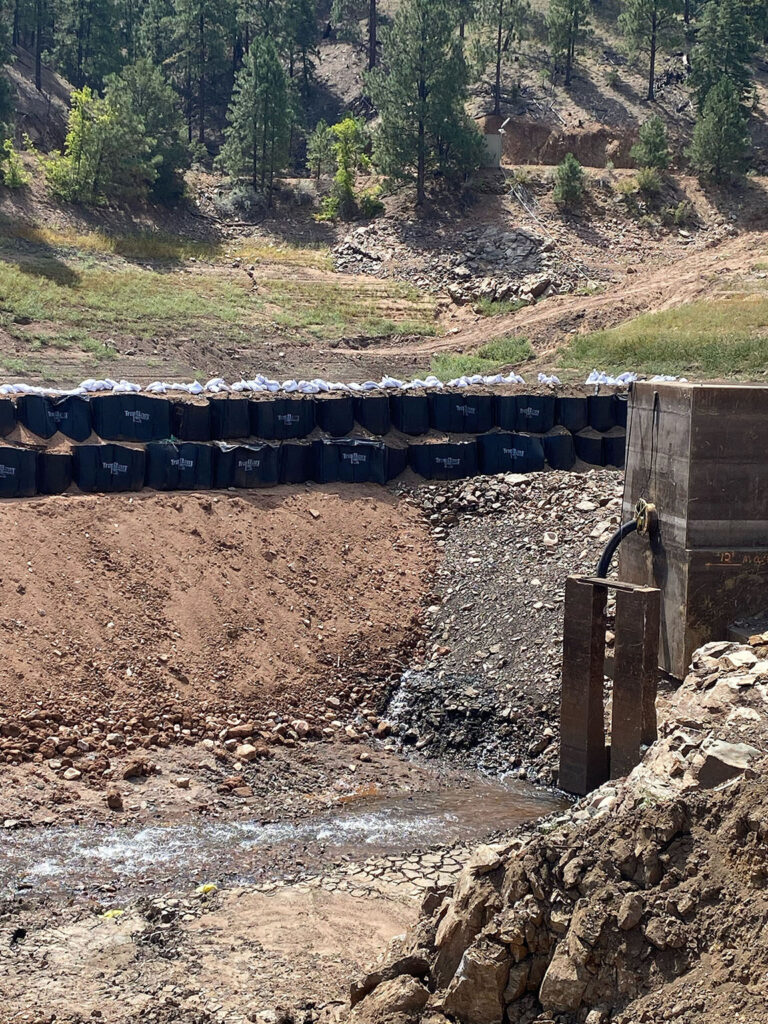Cofferdam Alternatives: TrapBags vs. Sheet Pile Cofferdams
TrapBags can offer a more affordable and flexible solution than sheet piling when it comes to building a strong cofferdam for water construction.

What Is a Cofferdam?
Cofferdam Definition
A cofferdam is a temporary dike that is built across water, allowing the water to be pumped out to expose the ground of the enclosed area. They are used when construction needs to be done in or over a body of water, such as a lake or river. By pumping the water out, the cofferdam creates a dry space for work to begin.
Cofferdams are often used for constructing or repairing bridges, building marinas, and constructing docs. They have been used for centuries and have assisted in the construction of large dams, such as the Hoover Dam.
Cofferdam Types
There are many different types of cofferdams available to choose from, depending on the size of the body of water, including:
- Braced: Braced cofferdams are made out of wood and constructed on land before being installed in a body of water. These cofferdams involve two lateral piles supported by cribs that create pockets. The pockets can then be filled with dirt or rocks.
- Cellular: A cellular cofferdam involves using steel sheet piles to create a cellular structure that can be filled with clay, sand, rock, or gravel. The cells can be customized to fit the size of the space and provide more height than other types of cofferdams can.
- Double-walled sheet pile: Double-walled cofferdams provide added stability, making them ideal for deeper waters.
- Earthen: Earthen cofferdams are typically used in more shallow waters and are made using natural materials, such as sand and dirt.
- Rockfill: Like earthen cofferdams, rockfill cofferdams are used in shallow water, but rock is used instead of dirt.
- Single-walled sheet pile: Single-walled cofferdams can be used in areas with moderate water levels for smaller sites such as bridge construction.
TrapBag cofferdams are cellular structures that create a strong enclosure so that water can be pumped out of the area. While other types of cofferdams require infiltrating the ground with sheet piles, cellular cofferdams do not, saving time and money.
Why TrapBags Are the Best Cofferdam Alternative
TrapBags vs. Sheet Piling Cofferdams
TrapBags are cellular cofferdams that can be set up without infiltrating the ground, while sheet piling cofferdams require driving steel sheet piling into the floor of the waterbed. This process requires more machinery, time, and money to construct. TrapBags offer a more efficient solution while remaining strong enough to withstand moderate water pressure at higher levels. TrapBags are also more versatile and can be customized to fit the space and stacked to meet the height requirements of the construction area.
Benefits of TrapBags
There are several benefits to choose TrapBags for cofferdams, including:
- Durable: TrapBags are constructed with high-strength textiles for durability during water control. They have proven to last for at least five years, withstanding floods, storms, winds, and mudslides.
- Dependable: Our cofferdams are individual, two-cell bags featuring a rectangular exterior reinforced with Coroplast interior paneling to prevent bulging. Their rectangular shape enables each bag to fit snugly against adjacent units to support the overall structural strength.
- Rapidly deployable: TrapBags can be installed and filled quickly for water barrier protection right when it’s needed. They are designed for easy lifting, allowing them to be pre-filled and then placed into position.
- Versatile: TrapBags can be used for a variety of water barrier structures, including dams, cofferdams, levees, dikes, and seawalls. They can be used on their own or stacked on top of existing barriers for extra height. TrapBags can be filled with material such as sand, clay, and gravel for a temporary wall, or they can be used as permanent structures when filled with cement.
- Easy to install: TrapBags do not require ground infiltration like other types of cofferdams and water barriers. Instead, they are easy to install and fill without any heavy and expensive equipment. TrapBags can also be folded up for easy storage and quick deployment.
- Cost effective: TrapBags are a cost-effective solution, using 40% less fill material than traditional sandbags. They also do not require costly steel frames that some other water barriers require.
TrapBag Cofferdam Construction
TrapBags can be used to build cofferdams by creating an enclosure across the water where the water will be pumped out until the bed is exposed. This allows for a dry area where construction or repairs can take place. They are available in both 2ft and 4ft sizes.
Learn Why TrapBags Are the Ideal Alternative to Sheet Piling
When you need a cofferdam for water construction, TrapBags are an ideal alternative to sheet piling. TrapBags are more cost-effective and versatile, giving you the water control barrier you need. Get started with your TrapBag solution today.
Meet the author
Get the Dirt Before the Flood Hits
Stay ahead of flooding, erosion, and disaster response challenges. The Dirt, TrapBag’s monthly newsletter, delivers field-tested tips, real-world case studies, and the latest in barrier technology straight to your inbox.

